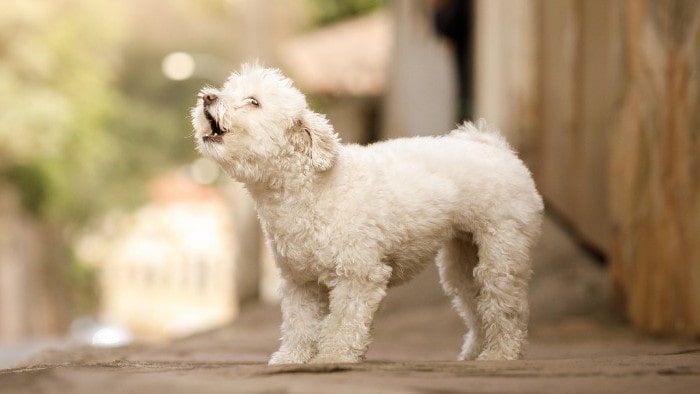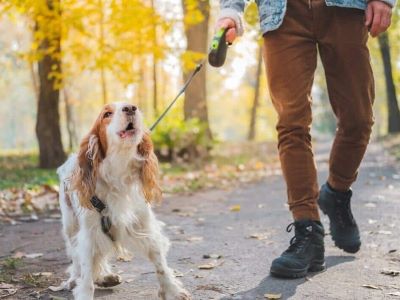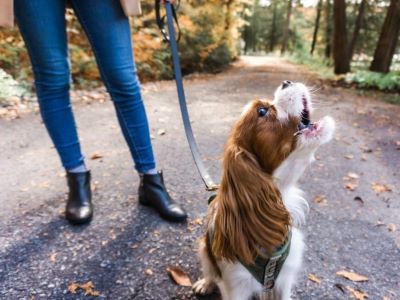Taking your dog for a walk is an enjoyable part of the day. But if your dog barks too much during walks it can be a problem, so you wonder “How do I stop my dog from barking when out walking?“🐕
It’s important to stop this excessive barking. Beyond just being annoying, it can harm relationships with others. You don’t want your dog to become known as the problem dog in the neighbourhood.🏠
The good news is there are ways to train your dog to walk calmly without all the barking. This will make walks🐕 much more pleasant for everyone, you, your dog and your neighbours.

How Do I Stop My Dog From Barking When Out Walking? Tips!
Dogs are just like us when it comes to reacting to their surroundings, Unknown noises, sights, or even smells can begin a curious barking session.
Pay attention to what captures your dog’s attention, it may be a postman, a passing car, or that mischievous squirrel🐿️. All of this can lead to vocal inquiry AKA barking!
Just like us humans dogs can feel uneasy or fearful in certain situations so, understanding this behaviour can help in managing their response to other dogs and people.
Tip 1) Use Positive Reinforcement Training
Now that you’ve understood why dogs may bark, it’s time to introduce positive reinforcement, a training technique that turns your dog into a well-behaved pup. Let’s see further:
👍 Use Treats and Rewards: Whenever your dog exhibits the right behaviour, perhaps a moment of silence or a calm reaction to a trigger, reward them quickly. This reinforces the idea that good behaviour equals tasty rewards[1].

👍Timing and Consistency: Timing is everything. When your dog behaves the way you want them to, reward them immediately. Consistency is the key🗝️, repeat this every time to engrain the desired behaviour in their brain.
👍Quiet and Calm Behaviour: Make it clear to your dog that calmness is the way to go. When they hush up or stay composed during potential trigger moments, shower them with positive reinforcement. It’s all about creating a positive association with tranquil behaviour.
👍Play and Engage During Walks: Walking🐕 isn’t just about putting one paw in front of the other, it’s an opportunity for play and interaction. Engage your dog in games, fetch, or simply joyful moments during your walks. This not only burns off excess energy but also makes the walk an enjoyable bonding experience.
👍Strengthening the Relationship: Be the leader your dog looks up to. Positive interactions, affectionate pets, and quality time together all contribute to a strong relationship. When your dog feels secure and connected to you, they are more likely to look to you for guidance during walks, reducing impulsive barking.
Consider using dog walking boots with traction to help keep your dog's focus on walking rather than being distracted and barking at things.
Tip 2) Use Basic Commands for Control
Imagine having a remote control to mute your dog’s barks. That’s what the “Quiet” or “Enough” command does.

- Dogs have an uncanny ability to be distracted by everything from interesting scents to fallen leaves. The “Leave it” command is your secret weapon.
- Whether it’s a tempting treat on the pavement or a particularly attractive squirrel,🐿️ this command helps your dog understand what they should avoid.
- Start in a controlled environment, maybe in your living room, and practice the commands. As your dog becomes proficient, slowly introduce distractions.
- This could be a squeaky toy or a tasty treat. The key is to take it slow, allowing your dog to build confidence in responding to your commands between mild distractions.
- Think of your dog as a young musician on a big stage. Begin your walks on calmer routes to reduce the chances of overwhelming triggers.
As you progress, gradually expose them to trigger stimuli: other dogs, people, or the exciting world🌍 around them.
Consider using dog walking boots with traction to help keep your dog's focus on walking rather than being distracted and barking at things. Be sure to properly measure your dog's paws. Check our guide on, "how to measure dog paws for boots" to get the right boot size.
Tip 3) Physical Exercise and Mental Stimulation
Begin the day with a strong play session or a brisk jog in the garden. A tired dog is a happy dog.
This not only burns off excess energy but also strengthens the bond between you and your four-legged friend. A game of chase or wrestling can be a fun and effective start to a peaceful walk.🐕
Introduce puzzle toys or treat dispensers that challenge your dog’s problem-solving skills. These toys often require them to figure out how to access a hidden treat.

Play a game of hide and seek with your dog’s favourite toy or treats. This taps into their instinct to hunt and keeps their mind engaged. It’s a mental treasure hunt that adds an extra layer of motivation.
Keep a variety of toys in rotation to prevent boredom. This mental freshness translates to a more relaxed behaviour during walks.
Engage in interactive games🧩 like ‘Find the hidden treat’ or ‘Name the toy.’ These games not only entertain your dog but also enhance their mental abilities.
Why Does Mental Stimulation Matter? A dog with a stimulated mind is less likely to react impulsively to every passing car or fluttering leaf, creating a more serene and enjoyable walking🐕 experience for both of you.
Tip 4) Avoid Negative Reinforcement: Positive Vibes Only!
Negative reinforcement involves removing or avoiding something unpleasant to encourage a desired behaviour. However, in the context of curbing barking, negative reinforcement is not ideal.
- “It may include scolding, shouting, or using devices that cause discomfort, methods that can escalate anxiety and, paradoxically, lead to increased barking”, confirms Erika Lessa at PetMD.🏥
- Dogs just like us, can experience stress and anxiety. Negative reinforcement not only fails to address the root causes of excessive barking but can also heighten your dog’s anxiety levels.
- Imagine trying to learn a new skill while constantly fearing criticism, it’s not the most motivating condition for effective learning.
- Positive reinforcement, on the other hand, builds trust and confidence in your dog. When they associate good behaviour with rewards and praise, it creates a positive feedback✅ loop.
- This strengthens the bond between you and your dog, fostering an environment where they feel safe to learn and adapt.

Why does Positive Reinforcement work better? When teaching dogs, positive reinforcement works. Just like learning a new language, an encouraging environment gets better results than criticism. The same goes for training dogs on walks.🐕 Reward good behavior🏆, don't punish the bad. Positivity curbs excessive barking.
Tip 5) Seek Vet’s Guidance
Just as you’d consult a doctor for your health, seeking a vet’s help for your dog’s behaviour is a wise step. A vet can help you whether it’s excessive barking, anxiety, or other behavioural concerns, their expertise ensures a personalised approach.
Excessive barking is often due to: fear, anxiety, or even health concerns. Their insights help decode what your dog is trying to communicate, allowing for a wider understanding of their behaviour.
Whether it’s reinforcing positive behaviour or introducing desensitisation exercises, their guidance empowers you to be an effective coach🐶👨🦰 for your dog.
Knowing that you’re on the right path, armed with expert advice, alleviates the stress and uncertainty that can come with addressing behavioural issues.
Tip 6) Be Patient!
Training your dog is a journey, not a destination!⭐
Establish a routine and stick to it. Whether it’s commands, introducing positive behaviours, or addressing triggers, consistency builds a strong foundation for your dog’s learning.

Dogs, much like us, need time to adapt and learn. Patience is your ally in improvements.
Celebrate small victories, be it a quieter walk🐕 or a well-executed command. If a particular method isn’t working then be flexible. Adapt your training techniques based on their response and feedback.
Consider teaching your dog the “Quiet” command. It’s natural to feel a sense of urgency for immediate results.
So, be patient while waiting for behavioural changes, your dog picks up on your energy. As Joyce Meyer said, "Patience is not the ability to wait, but the ability to keep a good✨ attitude while waiting."
FAQs
❓How Do I Get My Dog to Calm Down When Walking?
Practice having them walk next to you on a loose leash. Then have them sit multiple times on a walk just because you asked them to. You can also change your walking speed or normal route. All of these things will help your dog learn that you are in control on a walk.
❓How Do I Stop My Dog From Barking When Out Walking?
Start by teaching your pooch heel, so they walk in a controlled manner from the beginning, it also helps them understand you’re leading the walk, which in turn should help to enforce your training and command them to stop when barking.
❓Why Does My Dog Bark a Lot on Walks?
This may be due to your dog being uncomfortable with people or dogs on walks, and your pup may want to increase distance due to stress or anxiety. Alternatively, an excited or frustrated bark may be due to your pup not understanding impulse control.
❓Do Dogs Get Tired of Barking?
Dogs do not get tired of barking. The act of barking makes your dog want to bark more. Barking is a self-reinforcing dog behaviour, which means that the act of barking makes your best friend feel good. Other self-reinforcing behaviours, where the reward is the behaviour itself, are chewing and chasing.
❓What Is the Quiet Command for Dogs?
After 3-4, barks put a yummy treat in your dog’s face and when he stops barking to get the treat, you say “Quiet” (you do not have to shout, just use a normal tone of voice) – then say “YES” and give him the treat. 4. Repeat this 5-6 times per session and do a few sessions each day for a week.
Conclusion
In conclusion “How do I stop my dog from barking when out walking?“🐕 choose routes with fewer distractions while your dog is still learning.
Take them to more challenging areas gradually as their training progresses. Reward your dog with treats and praise when they are walking calmly without barking.
This will encourage good behaviour. The goal is peaceful walks where the only sound is your dog’s paws on the pavement, with time and consistency this will get better. Till then be patient!
Taking your dog for a walk is an enjoyable part of the day. But if your dog walks in circles during walks it can be a problem, so you may wonder "why do dogs walk in circles?"
Reference:
- Positive reinforcement training. (n.d.-e). The Humane Society of the United States.



